Tea egg 茶叶蛋 (a type of soy sauce egg 卤蛋 ) is a popular snack in the Chinese community. You will find street food vendors selling tea egg in the electric rice cooker, Hainanese chicken rice stores served it as a side dish, and Chinese medicine shop owner will add some medicinal herbs to the braising liquid for its health-boosting property.
Everyone likes tea egg because it is easy to prepare, nutritious, and can be prepared in advance (up to three days in the refrigerator). You only need a few common ingredients. Furthermore, there are no messy steps, and it is fun to make it.
Let’s dive right into the details of how to prepare the Chinese tea egg.
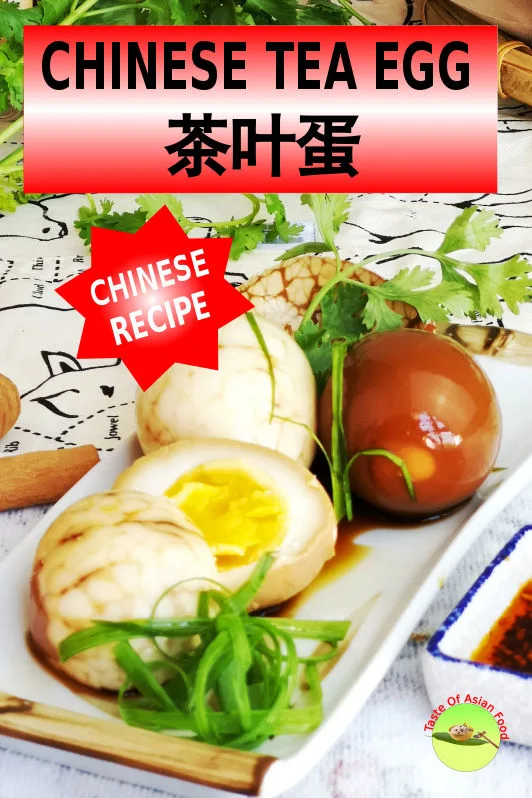
Note: This post may contain affiliate links. Please read my privacy policy for more info. I may receive commissions for purchases made through links in this post.
1 Boil the egg
Hard boil versus soft boil
The Chinese style tea egg is usually hard-boiled, whereas the Japanese version is with the egg yolk barely cooked.
You can prepare both by controlling the temperature and duration of cooking.
Here are the steps :
- Place the eggs in cold water.
- Bring the water to a boil.
- Reduce the heat to keep the water at barely simmering temperature.
- Simmer for another five minutes for the soft egg. If you prefer hard-boiled egg, simmer the soft egg in the flavoring liquid for another ten minutes. (Refer to step 3 below).
- When time is up, transfer the eggs into cold water to stop cooking immediately.
Placing the egg in ice water serves two purposes.
- First, it stops cooking immediately by lower the temperature quickly. As a result, it avoids further oxidation of the surface of the yolk, and preserve the bright color.
- Secondly, rapid cooling results in contraction of the egg, causing it to detach from the shell. That’s why it is easier to peel eggs after soaking in cold water.
With or without shell
After the eggs are cold, you can either remove the shell or knock the egg lightly with a metal spoon to create numerous cracks without removing the shell.
- If you remove the eggshell, the egg will contact the braising liquid fully, turning the egg to medium brown. The flavor is intense as a result of direct contact.
- If you only create multiple cracks without removing the shell, the braising liquid will only seep through the cracks, creating a marble-like pattern on the surface after removing the shell. The flavor may be less intense, but you can counteract it by braising/steeping the egg longer.
2. Constitute the flavoring liquid
The flavoring liquid comprises of tea, soy sauce, and spices. The barebone ingredients are tea, soy sauce, sugar, cinnamon, and star anise. However, the flavor will become more wholesome if you also include several secondary components. Let’s take a look at it one by one.
The key ingredients
Tea leaves. Tea leaves are the most important ingredient in this recipe. You can add a tea bag to the flavoring liquid. Black tea is commonly used in this recipe, but other types of teas are suitable too. For convenience, I add a bag of English Breakfast tea to my flavoring liquid in this recipe.
Soy sauce. The choice of soy sauce plays a vital role in the success of this recipe. The quality of soy sauce is also the biggest among all the ingredients.
This recipe requires Chinese light soy sauce since we are preparing the Chinese style tea egg. You can add a small amount of dark soy sauce to make the eggs darker after soaking in the liquid. If you want to make the Japanese style soy sauce egg (not this recipe), choose the Japanese soy sauce. The flavor is slightly different from the Chinese soy sauce.
Rock sugar. You can substitute it with regular white or brown sugar. It will not make a huge difference. I use rock sugar because I have it with me, which is the favorite type of sugar for braising in Chinese cooking.
Salt. The amount of salt required depends on the final amount of the flavoring liquid, which in turn depends on the size of the container to store the eggs. It also depends on the saltiness of the soy sauce that you choose. As a general guideline, I’ll add 1g of salt to every 100ml of water in the recipe.
The spices. The two most essential spices in this recipe are cinnamon and star anise. For simplicity, you can use a teaspoon of Chinese five-spice powder to substitute most of the spices in the recipe. I have provided this variation in the note section in the recipe.
The secondary ingredients
So, in theory, you can prepare the tea egg with only tea, soy sauce, cinnamon, star anise, and season with salt and sugar. However, it is the addition of the secondary ingredients that add the wholesomeness and variation of flavor to the tea eggs.
Ginger. Add a few slices of ginger to the flavoring liquid if you want to infuse the ginger flavor into the eggs.
Sichuan peppercorns. These peppercorns are widely used in Sichuan cuisines.l such as Dan Dan noodles and Hot and Sour Soup.
Dried chili. Spice up the flavoring liquid by adding one or more dried chilies.
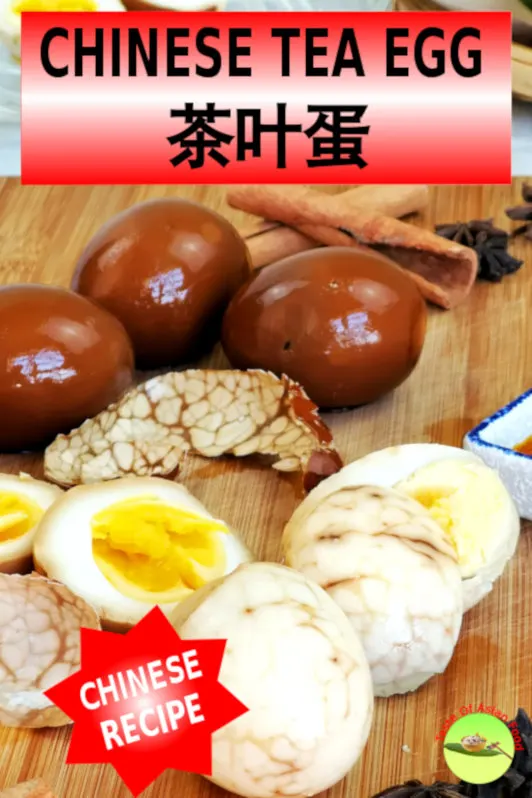
3. Cook and store the eggs
There are two ways to cook the eggs- braise the egg and steep the egg in the flavoring liquid for an extended period.
Method 1: Simmer the egg
This is the preferred method if you want to make the marble-like eggs. The heat during simmering will force the flavoring liquid to seep through the cracks.
You can create multiple cracks by knocking the egg against the tabletop or by using a spoon, but leave the shell intact. In this case, the flavor will only seep into the egg through the cracks and stain the egg to create a marble-like pattern.
Put the eggs with the cracked shells into the boiling liquid and let it simmer for ten minutes. The boiling liquid expedites the infusion of the flavor into the eggs.
The advantage of this method is speed but may tend to overcook the eggs and become rubbery. The heat will speed up the oxidation process, which can turn the bright yellow color of the egg yolk surface into grey.
Method 2: Steep the eggs for one day
This is my preferred method if you remove the shells of the eggs. The eggs will pick up the color of the liquid evenly, resulting in an even brown color. Since the eggs are not heated up once more, the oxidation of the surface of the yolk is slowing down, resulting in a much pleasant looking egg yolk.
Put the boiled egg into the flavoring liquid. Let the eggs steep in the liquid overnight to absorb the flavor from the liquid.
The eggs need more time to absorb the flavor by using the steeping method. Also, it is not very efficient to create a marble-like pattern even with the shell because the flavoring liquid is hared to penetrate the cracks without being heated up. You may need to steep the eggs for more than one day to get the desired deep savory flavor.
Storage
Many people will recycle the flavoring liquid. I suggest you boil it once more, then let it cools and frozen It.
As for the tea eggs, it can be kept up to three days in the refrigerator.
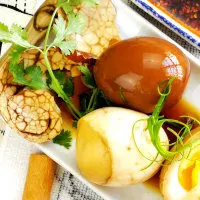
Chinese Tea Egg
Tea egg 茶叶蛋 is a popular snack among Chinese communities throughout the world.
Ingredients
- 10 eggs
- 2 black tea bags
- 2 Star anise *
- 10 cm Cinnamon *
- 1/2 tsp Sichuan peppercorns *
- 2 bay leaf*
- 4 slices ginger
- 500ml Water
- 80 ml light soy sauce
- 20ml dark soy sauce
- 20 g Sugar
- 5g salt
Instructions
- Place the eggs in the water.
- Add a teaspoon of salt.
- Bring the water to a boil, then reduce the heat to simmer for another five minutes.
- Transfer the eggs into ice water until it is cold.
- Place all the ingredients except the egg in a pot. Simmer for ten minutes.
- Make some cracks on the shell of all the eggs with a metal spoon.
- Simmer the eggs in the flavoring liquid for twenty minutes.
- Transfer the eggs and the liquid into another container. Let the eggs steep for another half a day. Serve.
Notes
Simplified method: Substitute all the ingredients with * in the recipe with 2 tsp of Chinese five-spice powder.
Recommended Products
As an Amazon Associate and member of other affiliate programs, I earn from qualifying purchases.
Nutrition Information:
Yield: 6 Serving Size: 6 eggsAmount Per Serving: Calories: 115Total Fat: 5gSaturated Fat: 2gTrans Fat: 0gUnsaturated Fat: 3gCholesterol: 186mgSodium: 1416mgCarbohydrates: 10gFiber: 1gSugar: 4gProtein: 8g
This data was provided and calculated by Nutritionix on 10/10/2019



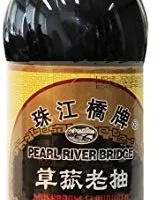
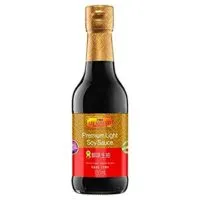
Steamed eggs with minced pork - easy Chinese recipe (肉碎蒸蛋)
Thursday 7th of November 2024
[…] Traditional Chinese Tea Eggs: If you like egg dishes, don’t miss out on this classic Chinese tea egg recipe. […]
David Bridges
Monday 14th of October 2019
KP - you publish some really interesting recipes! regarding chinese tea eggs, how do these compare in flavour with thousand year old eggs?
KP Kwan
Monday 14th of October 2019
The century eggs (or 1000 years eggs) are traditional Chinese delicacy. The chicken or duck eggs are preserved in a mixture of clay, ash, salt, quicklime for 15 to 20 days. Over time, the color of the yolk becomes dark green with a creamy consistency and strong flavor due to the hydrogen sulfide and ammonia present, while the egg white turns to a dark brown, translucent jelly with a salty flavor. It looks and tastes totally different from this tea egg. The best way to know is to get one to try :)
KP Kwan
Saturday 12th of October 2019
Hi, this is KP Kwan. I am happy to see you in this comment area, as you have read through my recipe. I am pleased to reply to any questions and comments as soon as possible.